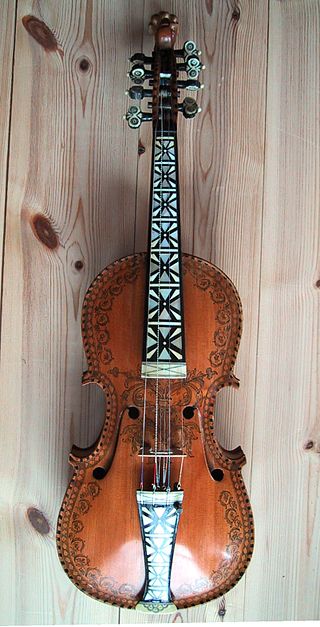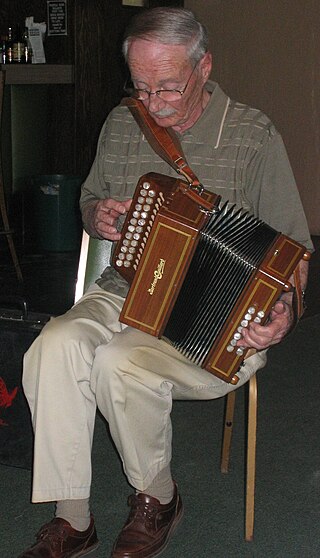Related Research Articles

A fiddle is a bowed string musical instrument, most often a violin. It is a colloquial term for the violin, used by players in all genres, including classical music. Although in many cases violins and fiddles are essentially synonymous, the style of the music played may determine specific construction differences between fiddles and classical violins. For example, fiddles may optionally be set up with a bridge with a flatter arch to reduce the range of bow-arm motion needed for techniques such as the double shuffle, a form of bariolage involving rapid alternation between pairs of adjacent strings. To produce a "brighter" tone than the deep tones of gut or synthetic core strings, fiddlers often use steel strings. The fiddle is part of many traditional (folk) styles, which are typically aural traditions—taught "by ear" rather than via written music.

Irish dance refers to a group of traditional dance forms that originate in Ireland, encompassing dancing both solo and in groups, and dancing for social, competitive, and performance purposes. Irish dance in its current form developed from various influences such as earlier native Irish dance, English country dancing and later possibly French quadrilles, as it became popular in Britain and Ireland during the 19th century. Dance was taught by "travelling dance masters" across Ireland in the 17th and 18th centuries, and separate dance forms developed according to regional practice and differing purposes. Irish dance became a significant part of Irish culture, particularly for Irish nationalist movements. From the early 20th century, a number of organisations promoted and codified the various forms of dance, creating competitive structures and standardised styles. Irish dancers who compete for competitive reasons dance in a dance style that is more modern than traditional Irish dance. It is mainly done solo, but there is some team dancing in groups of 2, 3, 4, 6, 8, 10, 16 and even numbers onwards.

A cèilidh or céilí is a traditional Scottish and Irish social gathering. In its most basic form, it simply means a social visit. In contemporary usage, it usually involves dancing and playing Gaelic folk music, either at a home or a larger concert at a social hall or other community gathering place.

A Hardanger fiddle is a traditional stringed instrument considered to be the national instrument of Norway. In modern designs, this type of fiddle is very similar to the violin, though with eight or nine strings and thinner wood. The earliest known example of the hardingfele is from 1651, made by Ole Jonsen Jaastad in Hardanger, Norway. Originally, the instrument had a rounder, narrower body. Around the year 1850, the modern layout with a body much like the violin became the norm.

The Irish flute is a conical-bore, simple-system wooden flute of the type favoured by classical flautists of the early 19th century, or to a flute of modern manufacture derived from this design. The majority of traditional Irish flute players use a wooden, simple-system flute.

Irish stepdance is a style of performance dance with its roots in traditional Irish dance. It is generally characterized by a stiff upper body and fast and precise movements of the feet. It can be performed solo or in groups. Aside from public dance performances, there are also stepdance competitions all over the world. These competitions are often called Feiseanna. In Irish dance culture, a Feis is a traditional Gaelic arts and culture festival. Costumes are considered important for stage presence in competition and performance Irish stepdance. In many cases, costumes are sold at high prices and can even be custom made. Each costume is different, with varying colors and patterns, designed to attract the judge's eye in competitions and the audience's eye in performance. General appearance beside the costume is also equally important. Female dancers would typically curl their hair before each competition or wear curled wigs, while male dancers would neatly style their hair to a shape to their liking. Poodle Socks are worn by female dancers while males wear plain black socks. Poodle socks are white socks that stretch to typically 1-4 inches above the ankle, depending on the dancers preference. They also have distinctive ribbing, and can be embroidered with gems.
The White Heather Club was a BBC TV Scottish variety show that ran on and off from 7 May 1958 to 11 April 1968
In modern competitive Irish dance, an oireachtas refers to an annual championship competition. Oireachtais are held by several Irish dance organisations globally, including An Coimisiún Le Rincí Gaelacha, An Comhdhail na Múinteoirí le Rincí Gaelacha, the World Irish Dance Association, and others. Many oireachtais include both solo and ceilí (team) events. The competitions vary in size, duration, and level of eligibility.

Joe Derrane was an Irish-American button accordion player, known for re-popularizing the D/C# system diatonic button accordion.

Irish traditional music is a genre of folk music that developed in Ireland.
Josie McDermott (1925–1992) was a traditional Irish musician: a flute and tin whistle player, composer and singer.
Paddy Canny was an Irish fiddle player. In a career that spanned over six decades, Canny was instrumental in popularizing Irish traditional music, both in Ireland and internationally. He gained initial fame in the late 1940s as a founding member of The Tulla Céilí Band, which made its first appearance on RTÉ Radio in 1948 and had positioned itself as the top céilí band in Ireland by the late 1950s.
The Tulla Céilí Band is an Irish céilí band.
Junior Crehan was an Irish fiddle player who composed a number of tunes that remain popular within the Irish Traditional Music community.
John Francis (Boss) Murphy (1875–1955) from The Leap, Churchtown, Co. Cork was a farmer by profession, but possessed a keen interest in fiddle playing, and was renowned locally for his ability on the instrument. His father, William Murphy (1829–1911), was both a fiddle player and maker, indeed John was the proud owner of an instrument that had been made by his father, who was his first fiddle teacher. His siblings, a brother, and three sisters, also played the instrument but their interest in music waned as they reached adulthood and they did not continue to play. Murphy's musical literacy was also gained primarily from his father, who had learned to read music at a hedge school at Ballygrace in the locality taught by Thomas Croke. The same Thomas Croke, many years later, stayed for long periods in the Murphy household and would undoubtedly also have taught the young John Murphy directly.

Róisín Mullins is a TV presenter, TV talent show judge, professional Irish dancer, singer, stage show owner and choreographer.

An Coimisiún Le Rincí Gaelacha is the oldest and largest governing body for competitive Irish step dancing globally. Founded in 1927, CLRG is responsible for creating a standardised system of Irish dance, music and competition for its member organisations in 26 countries. It organises Oireachtas Rince na Cruinne as well as Oireachtas Rince na hÉireann, and is the central authority for teacher and adjudicator accreditation. It is headquartered in Dublin, Ireland.

Comhdháil na Múinteoirí le Rincí Gaelacha, also referred to as An Chomhdháil, is a global governing body for Irish stepdance. Founded in the early 1960s, and then breaking from An Coimisiún Le Rincí Gaelacha to become an independent organisation, An Chomhdháil is today the second-largest Irish dance organisation and one of six to run a World Championships competition.

Oireachtas Rince na Cruinne is an annual Irish stepdance competition run by An Coimisiún Le Rincí Gaelacha. The Worlds include competitions for solo stepdance, organised by gender and age; and for certain traditional and original ceili dances, also divided by age group and team gender composition. Oireachtas Rince na Cruinne is the top competition of the hierarchical system operated by An Coimisiún, and dancers must qualify at major Irish stepdance events across the world in order to compete.

The Gardiner Brothers are professional Irish dancers, social media personalities and influencers. Michael and Matthew are Irish-American dancers and choreographers who are currently living in Galway, Ireland. They are both cast members of Riverdance and have toured the world extensively since auditioning for the show in 2015. They are known for their rhythm, innovation and syncopation and have both won the Irish dancing World Championship multiple times.
References
- 1 2 "Come Haste to the Wedding". Thoughts on Dance: Dancing and Reenacting 18th Century Dance. Retrieved 12 August 2017.
- ↑ Phillips, Bob; Dabczynski, Andrew H. (2009). Basic Fiddlers Philharmonic - Viola: Celtic Fiddle Tunes. Alfred Music. p. 20. ISBN 9781457434600 . Retrieved 12 August 2017.
- ↑ Abbott, Elizabeth (2011). A History of Marriage: From Same Sex Unions to Private Vows and Common Law, the Surprising Diversity of a Tradition. Seven Stories Press. ISBN 9781609800857 . Retrieved 12 August 2017.
- ↑ Rose, Keith. "Haste To The Wedding Dancing Instructions". Scottish Country Dancing Dictionary. Retrieved 12 August 2017.
- ↑ Ar Rinci Ceili. Dublin: An Coimisiun Le Rinci Gaelacha. 2014.
- Source for notated version: Smith Paine (Wolfboro, N.H.) [Linscott]. Linscott (Folk Songs of Old New England), 1939; pg. 87. Sweet (Fifer's Delight), 1964/1981; pg. 24.